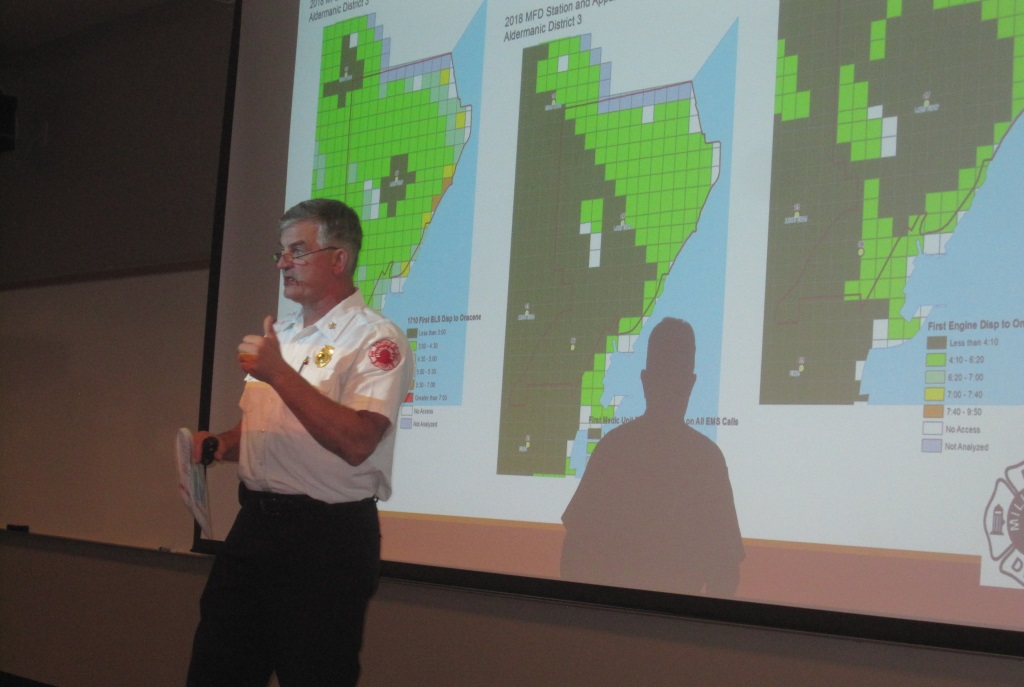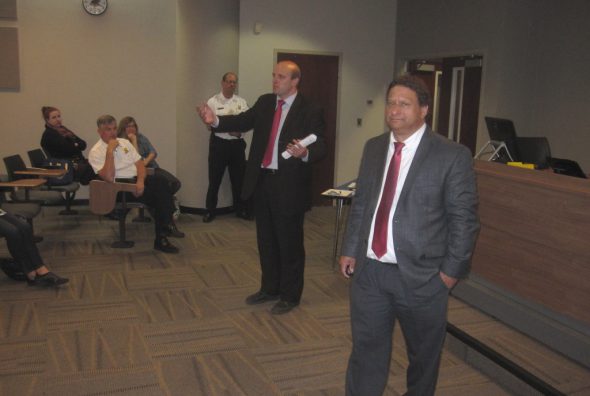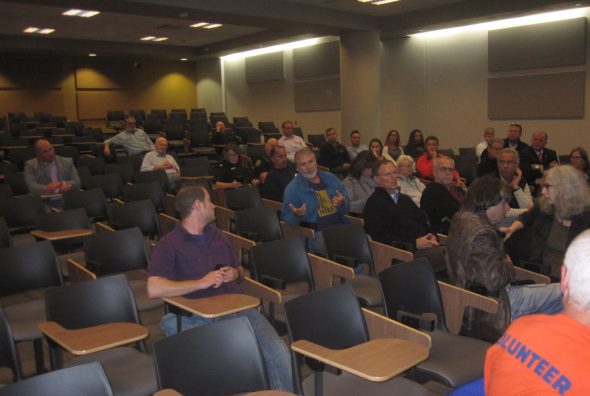Neighbors Fight for Brady St. Fire Station
But by the end of public meeting held by Ald. Kovac many seemed resigned to its loss.
The firefighter is the most dashing and brave of civil servants, with a chosen profession rich in romance and legend. Young children dream of becoming one some day — in fact, for some families the job is every bit as hereditary as a Dukedom, with service stretching back generations. As a municipal building, the aptly named “Fire House” is unique in that it includes such domestic arrangements as sleeping quarters and a kitchen for those therein employed.
No Milwaukee fire house is more beloved than Engine Co. 6, which has served the Brady Street neighborhood since 1875 from its site at 1693 N. Franklin Pl., at the southwest corner of the commercial street that gives the neighborhood its name.
The fire house, constructed in 1946, is built right up to E. Brady St., and passersby can catch a whiff of the home cooking that emanates from the kitchen. The aromas rival those of the many restaurants on the well-fed street.
The area the station serves is the most densely populated in the state, as well as among its fastest growing. It has a high concentration of aged housing stock, of largely detached frame construction, and a considerable population of the elderly housed in the both public and private senior living facilities. The area has most of the tallest residential buildings in the state, and a challenging geography that deviates from the Milwaukee grid, as well as including precipitous elevation changes of 100 feet or more at the bluffs. It also has its share of transients, homeless, the mentally ill and drinkers on a bender, all public safety concerns.
Yet when Fire Chief Mark Rohlfing tasked his Firefighting Deputy Chiefs to identify savings to accommodate the Mayor’s proposed budget cuts, the analysis by Deccan software and the experience of his deputies identified Engine 6 as the prime spot to close. The reaction in the community was a widespread sense that the residents and businesses would rather the station remain open.
Earlier this week, Bruce Murphy discussed the dynamics at play for modern fire departments, where the number of fires has declined, yet the number of career professionals employed to fight them has increased. A more recent fiscal accelerant to the red-hot budget issue is the loss of state shared revenue and the growth in employer pension contributions the city is obliged to make.
A Public Informational Session
On Wednesday, Ald. Nik Kovac invited officials to discuss the changes that he and other council members will vote on during budget adoption meetings early next month.
The session, which drew over 135 neighbors, including active and retired fire fighters and their families, was held at UW-Milwaukee’s Lubar School of Business Administration in the Michael J. Cudahy Lecture Hall.
Kovac was joined by Rolfing and Dennis Yaccarino, the city’s budget and management director, who had been appointed to his position only last month, after years of serving as an economist and as city financial operations manager. For such a newcomer to the job, explaining the city’s budget structural issues before this audience was a veritable trial by fire.
Yaccarino said the city faces some structural issues that must lead to either new revenue sources or further budget cuts in coming years.
Expenses Growing:
- Total Budget — $1.531 billion
- Tax Levy — $273.4 million
- Overall, the city’s expenses grow by 2 percent to 3 percent a year, which translates to up to $19 million in organic increases.
- Despite a 3 percent increase in municipal fees, non-property tax revenues increase by less than 1 percent annually
- Fees may not be increased beyond program recovery costs due to state limits
- Nor may the property tax levy be increased beyond state-set limits
- A $22 million increase in pension costs must be absorbed. System is 96 percent fully funded
- Debt service and pension contribution have risen from 27 percent of total tax levy in 2004 to 52.7 percent in 2018
This leaves a $28 million gap between expenditures and revenues.
Furthermore, Yaccarino was obliged to tell the recipients, despite legislation and news reports to the contrary, the capital and operations budget of The Hop, the Milwaukee Streetcar, has no impact on these figures.
Revenues Don’t Keep Up:
- No organic growth in revenues
- Tax Levy increase of 3.7 percent, the maximum permitted, will fill $9.7 million of gap
- Remaining gap — $18.3 million
- Inflation adjusted decline in annual state revenue sharing 2003-2018 — $104.3 million
According to Yaccarino, the ideal solution would be for the state to restore equitable shared revenue funding to the City of Milwaukee, explaining that reversing the $104 million annual real dollar decline since 2003 would solve many problems, and restore integrity to the city’s financial structure.
Ald. Kovac mentioned the century-old tradition of having the state levy an income tax which would then be remitted to municipalities according to a formula, which has since been abrogated, costing Milwaukee hundreds of millions of dollars, he said.
Yaccarino said an alternative solution would be to have the city enact a 0.5 percent sales tax dedicated to public safety, thus removing some volatility from the funding source.
Audience Reaction
Chief Rohfling defended his decision to close Engine 6 and to repurpose it as a Public Education center. He recalled a time when calculations of station openings and closings were made by stopwatch as trucks tested different routes and travel conditions. Now they are dictated by GPS and computer algorithms such as the Daccan system that helped plot the demise of Engine 6.
“Engine Six is the face of the fire department in the city,” one attendee said, addressing the panel, as murmurs of assent filled the room.
Frank Alioto, the retired Engine 6 Captain who wrote the history of the Brady Street neighborhood, faulted the Daccan computer study, finding it “skews too much on geography rather than the reality of what is there,” a sentiment that also appeared to be widely shared by audience members, who noted the great number of elderly, the many businesses in the area, its growth and density and such omnipresent potential hazards as a river with a reversible current, and the 1,197 cubic miles of fresh lake water, both located just a couple of blocks from the beloved engine house.
“Whether or not we lose this battle, it is important to lobby on the state level for local control,” Alioto concluded.
Another attendee objected to the plan to repurpose the station as an Public Education center, saying “it sounds like we are being thrown a bone,” in lieu of shuttering the building on its prominent corner. Another called it an “insult.”
This appeared to take the fire chief by surprise.
Brady Street would be a good location for the public education facility, which is now buried in the remote Teutonia facility, he said: “Not to insult anybody, but this would be a great use for the building.”
Yet even so, in an audience passionate about their neighborhood, and a group of firefighters passionate about their careers, their fellows, and their history, there seemed to be a sense of resignation, that if the fire house were to go, then let it go.
“It seems contrived to me to keep it as a (Public Education) house,” one said. “Put it on the tax rolls. Find another use for it.”
The suggestion, somewhat surprisingly, resulted in cheers and applause.
Engine House 6 would indeed make a fine restaurant, like its formerly beloved counterpart, Engine Company 3, 217 W. National Ave. Reservations now taken.
Plenty of Horne
-
Villa Terrace Will Host 100 Events For 100th Anniversary, Charts Vision For Future
 Apr 6th, 2024 by Michael Horne
Apr 6th, 2024 by Michael Horne
-
Notables Attend City Birthday Party
 Jan 27th, 2024 by Michael Horne
Jan 27th, 2024 by Michael Horne
-
Will There Be a City Attorney Race?
 Nov 21st, 2023 by Michael Horne
Nov 21st, 2023 by Michael Horne
























With all of the recent residential growth, why is city “revenue” not increasing?
@ Mike The city isn’t growing in population, it remains steady at around 600,000 (inflow/outflow).
Mike makes a good point, though the growth as it applies to something like this fire station issue is not the population, which as Sam notes, might not be changing, but the property tax change from the new residential developments.
It’s either the case that real change has not yet been recognized or it’s only been enough to cover the organic growth in expenses. Also, in the cases where TIFs were used, there is no new net revenue yet, it’s all paying off debt
@Rich I’d like to look at it a bit more but here are the Tax Base Values for the City of Milwaukee that might be of help:
2008 $30,431,675,204 Top
2014 $25,024,542,439 Bottom after recession
2015 $25,262,963,417
2016 $25,974,258,965
From 2008-2014 the city lost $5 Billion in tax base… only since 2014 has it began increasing again, but it is increasing again. Maybe not enough?
I’m curious how much growth in tax base/revenue from property taxes are currently tied up in TIF/TID districts. It’s a very powerful economic development tool, but it can tie up revenue for the city for a number of years while the improvements are completed.
For example, a TIF district sees a new high rise, or commercial building, with a significantly increased value to the city, but the city won’t see the increase in value until the TIF/TID closes.